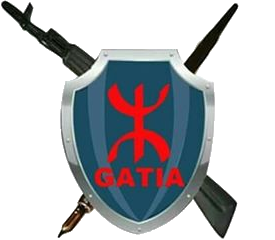
The Imghad Tuareg Self-Defense Group and Allies is an armed group in Azawad, Mali. Most of its 500 to 1,000 fighters are Imghad Tuaregs, and the group supports the Malian government.

The Movement for the Salvation of Azawad is a Tuareg political movement and armed group in Azawad, Mali. It was founded on 2 September 2016 by Moussa Ag Acharatoumane.
The Battle of Andéramboukane occurred between 4 and 5 June 2022, during the Ménaka offensive of the Mali War. The pro-government militias Movement for the Salvation of Azawad (MSA) and Imghad Tuareg Self-Defense Group and Allies (GATIA) attempted to retake the Islamic State-held town of Andéramboukane but were unsuccessful.
On January 15, 2019, militants from the Islamic State in the Greater Sahara attacked two villages in Ménaka, Mali, killing at least 40 people. The massacres were targeted against Tuaregs.
The Ménaka offensive was a series of offensives launched by the Islamic State in the Greater Sahara against the Malian Army, Tuareg self-defense groups including the Movement for the Salvation of Azawad (MSA) and Imghad Tuareg Self-Defense Group and Allies (GATIA), and the al-Qaeda-aligned Jama'at Nasr al-Islam wal Muslimin. The offensives took place in the Ménaka Cercle, in southeastern Mali.
Hassan Ag Fagaga, born around 1959 or 1966, in Kidal, Mali, was a Malian soldier and a Tuareg rebel.
On December 11 and 12, 2018, Islamic State in the Greater Sahara fighters attacked Daoussahak Tuareg refugee camps in the villages of Tinabaw, Tabangout and Tissalatatene, all in the Ménaka Cercle of Mali. Between 43 and 47 civilians were killed by ISGS.
On April 26 and 27, 2018, militants from the Islamic State in the Greater Sahara attacked two refugee camps near Andéramboukane, Ménaka, Mali, killing forty-seven people, mostly Tuareg civilians.
El Hadj Ag Gamou, born December 31, 1964, in Tidermène, Mali, is an Imghad Tuareg Malian division general. Gamou is currently the governor of Kidal Region since November 22, 2023, and has also been the head of his faction of Imghad Tuareg Self-Defense Group and Allies since the group's foundation. Prior to his governorship, Gamou served in the Malian army, commanding Malian troops against Ansar Dine and the National Movement for the Liberation of Azawad (MNLA) in the early stages of the Mali War.

The High Council for the Unity of Azawad (HCUA) (French: Haut conseil pour l'unité de l'Azawad) is a Tuareg political movement formed on May 2, 2013, during the Mali War. The movement was initially called the High Council of Azawad (HCA) (French: Haut conseil de l'Azawad) before changing its name on May 19, 2013.
On 10 August 2016, clashes broke out between pro-government GATIA militiamen against Coordination of Azawad Movements (CMA) aligned groups near Adjlal, Kidal Region, Mali.
On July 30, 2016, clashes broke out between GATIA and the Coordination of Azawad Movements in Touzik, Kidal Region, Mali.
The battle of Kidal took place between July 21 and 22, 2016 between GATIA, a pro-government militia consisting of Imghad Tuaregs, against the Coordination of Azawad Movements, consisting of Ifoghas Tuaregs.
On August 17, 2015, clashes broke out between pro-government GATIA militants and rebels from the Coordination of Azawad Movements (CMA) in the town of Anefis and surrounding areas. The dispute was settled in September.
On January 28 and February 4, 2015, pro-government Imghad Tuareg GATIA fighters attacked a base staffed by Arab Movement of Azawad (MAA) fighters in Tabrichat, Mali.

On October 16, 2014, clashes broke out between the pro-government GATIA miltiia and the National Movement for the Liberation of Azawad in N'Tillit, Mali.
Between July 19 and 22, 2014, pro-government rebels from GATIA and other militias clashed with rebels from the MNLA, HCUA, and dissident MAA in Tabankort, rural Gao Region, Mali. Clashes were paused after MINUSMA intervened.
The Kidal offensive was an offensive by the Malian government and Wagner Group mercenaries against the rebel coalition Permanent Strategic Framework for Peace, Security, and Development (CSP-PSD) with the aim of capturing the rebel-held region of Kidal. The offensive was part of a renewed conflict between the Malian junta that took power in 2021 and former Tuareg rebel groups that had signed the Algiers Agreement in 2015, creating a ceasefire and de facto rebel control over the region. The offensive was also an attempt by Malian forces to seize control over MINUSMA camps in Kidal Region after the Malian junta had ordered the mission to leave the country by the end of 2023.
The battle of Kidal took place between November 10 and 14, 2023, during the Kidal offensive in renewed conflict between the CSP-PSD and the Malian Armed Forces and allied Wagner Group mercenaries during the Mali War. The city of Kidal had been under rebel control since 2014, and the 2015 Algiers Agreement enacted a ceasefire and Kidal Region subsequently was de facto controlled by rebel groups. When Malian and Wagner forces captured the city on November 14, it marked the first time in nine years that all Malian regional capitals were fully under Malian government control.
Fahad Ag Almahmoud was a Malian Imghad Tuareg militant who served as the secretary-general of GATIA from its formation in 2014 until 2023, when he split from the group and formed his own faction of GATIA.



